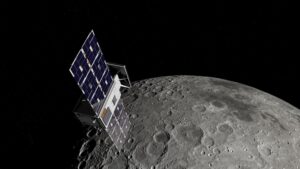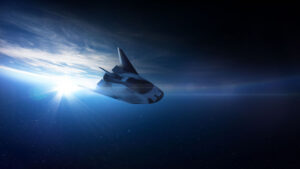LeoLabs awarded contract from US Dept of Commerce to support space traffic management prototype
Sunday, 11 September 2022 09:52 LeoLabs, Inc., the world's leading commercial provider of low Earth orbit (LEO) mapping and Space Situational Awareness (SSA) services, has announced an award to provide data and services to the US Department of Commerce to support the development of a US civil- led Space Traffic Management (STM) system. The announcement was made at the 9th session of the National Space Council in Houston, Texas
LeoLabs, Inc., the world's leading commercial provider of low Earth orbit (LEO) mapping and Space Situational Awareness (SSA) services, has announced an award to provide data and services to the US Department of Commerce to support the development of a US civil- led Space Traffic Management (STM) system. The announcement was made at the 9th session of the National Space Council in Houston, Texas New mineral found by Chinese scientists
Sunday, 11 September 2022 09:52 Chinese scientists have achieved a remarkable new feat in their research of the moon as they have discovered and identified the sixth new lunar mineral.
The China National Space Administration and the China Atomic Energy Authority jointly announced in Beijing on Friday that the new mineral-Changesite-(Y)-was found by scientists at the Beijing Research Institute of Uranium Geology from surf
Chinese scientists have achieved a remarkable new feat in their research of the moon as they have discovered and identified the sixth new lunar mineral.
The China National Space Administration and the China Atomic Energy Authority jointly announced in Beijing on Friday that the new mineral-Changesite-(Y)-was found by scientists at the Beijing Research Institute of Uranium Geology from surf SpaceX launches 34 more Starlink satellites, AST SpaceMobile satellite
Sunday, 11 September 2022 09:52 Elon Musk's SpaceX launched 34 more Starlink satellites with AST SpaceMobile's BlueWalker 3 satellite to low-Earth orbit on Saturday.
The satellites were launched by a two-stage Falcon 9 rocket from Launch Complex 39A at Kennedy Space Center in Florida after targeting a 9:20 p.m. liftoff due to weather.
The first stage of the Falcon 9 rocket landed on the A Shortfall of Gravitas
Elon Musk's SpaceX launched 34 more Starlink satellites with AST SpaceMobile's BlueWalker 3 satellite to low-Earth orbit on Saturday.
The satellites were launched by a two-stage Falcon 9 rocket from Launch Complex 39A at Kennedy Space Center in Florida after targeting a 9:20 p.m. liftoff due to weather.
The first stage of the Falcon 9 rocket landed on the A Shortfall of Gravitas Could Ukraine become a strong ally ESA has been looking for
Sunday, 11 September 2022 09:52 The European Space Agency (ESA) said in June that it expects strong support from NASA after the European agency suspended its cooperation with Russia due to the Ukraine war.
"Administrator Bill Nelson has given us a clear message: NASA wants to help Europe in this situation," said ESA Director General Josef Aschbacher.
ESA wants to find a silver-bullet solution here and now to cover
The European Space Agency (ESA) said in June that it expects strong support from NASA after the European agency suspended its cooperation with Russia due to the Ukraine war.
"Administrator Bill Nelson has given us a clear message: NASA wants to help Europe in this situation," said ESA Director General Josef Aschbacher.
ESA wants to find a silver-bullet solution here and now to cover MEASAT signs multiyear Managed Bandwidth Services contract with Reach Ten
Sunday, 11 September 2022 09:52 MEASAT Global Berhad ("MEASAT") - Malaysia's premier satellite operator, has signed a multiyear contract with Reach Ten Communication Sdn Bhd ("Reach Ten") for Managed Bandwidth Services, supported by the high throughput satellite ("HTS") payload on MEASAT-3d ("M3d"). With this contract, Reach Ten will become the largest enterprise satellite service provider in Malaysia in terms of capacity prov
MEASAT Global Berhad ("MEASAT") - Malaysia's premier satellite operator, has signed a multiyear contract with Reach Ten Communication Sdn Bhd ("Reach Ten") for Managed Bandwidth Services, supported by the high throughput satellite ("HTS") payload on MEASAT-3d ("M3d"). With this contract, Reach Ten will become the largest enterprise satellite service provider in Malaysia in terms of capacity prov Harris talks with space station astronauts, introduces new initiatives
Sunday, 11 September 2022 09:52 Vice President Kamala Harris spoke to astronauts serving on the International Space Station on Friday as she convened the meeting of the National Space Council at the Johnson Space Center in Houston.
In the call, Harris talked about the importance of protecting Earth and joining forces to meet other space initiatives. She is the chair of the council.
"Tell us what you are learnin
Vice President Kamala Harris spoke to astronauts serving on the International Space Station on Friday as she convened the meeting of the National Space Council at the Johnson Space Center in Houston.
In the call, Harris talked about the importance of protecting Earth and joining forces to meet other space initiatives. She is the chair of the council.
"Tell us what you are learnin Is over-eating to blame for bulges in Milky Way bar
Sunday, 11 September 2022 09:52 A new simulation conducted on the world's most powerful supercomputer dedicated to astronomy has produced a testable scenario to explain the appearance of the bar of the Milky Way. Comparing this scenario to data from current and future space telescopes will help clarify the evolution of our home Galaxy.
Astronomy is revealing the structure of the Milky Way Galaxy in which we live in incre
A new simulation conducted on the world's most powerful supercomputer dedicated to astronomy has produced a testable scenario to explain the appearance of the bar of the Milky Way. Comparing this scenario to data from current and future space telescopes will help clarify the evolution of our home Galaxy.
Astronomy is revealing the structure of the Milky Way Galaxy in which we live in incre OneWeb and HD Hyundai Avikus to advance marine technology by unlocking the potential of LEO connectivity
Sunday, 11 September 2022 09:52 OneWeb, the low Earth orbit (LEO) satellite communications company, and HD Hyundai Avikus, a world leader in advanced autonomous ship, has announced the signing of a Memorandum of Understanding (MoU).
This agreement, signed during a dedicated ceremony at SMM Hamburg 2022, signifies a new partnership to explore opportunities for advanced LEO satellite technology to support the next generati
OneWeb, the low Earth orbit (LEO) satellite communications company, and HD Hyundai Avikus, a world leader in advanced autonomous ship, has announced the signing of a Memorandum of Understanding (MoU).
This agreement, signed during a dedicated ceremony at SMM Hamburg 2022, signifies a new partnership to explore opportunities for advanced LEO satellite technology to support the next generati Iridium announces 9th SpaceX launch
Sunday, 11 September 2022 09:52 Iridium Communications Inc. (NASDAQ: IRDM) reports it has reached an agreement with SpaceX to launch up to five of the company's remaining ground spare satellites from the Iridium NEXT program, on its Falcon 9 rocket.
Known as Iridium-9, the launch is planned to take place at Vandenberg Space Force Base in mid-2023. Earlier this year, Iridium celebrated the 25th anniversary of the first la
Iridium Communications Inc. (NASDAQ: IRDM) reports it has reached an agreement with SpaceX to launch up to five of the company's remaining ground spare satellites from the Iridium NEXT program, on its Falcon 9 rocket.
Known as Iridium-9, the launch is planned to take place at Vandenberg Space Force Base in mid-2023. Earlier this year, Iridium celebrated the 25th anniversary of the first la Foundation model improves accuracy for remote sensing image interpretation
Sunday, 11 September 2022 09:52 A new foundation model dubbed RingMo has been developed to improve accuracy for remote sensing image interpretation, according to the Aerospace Information Research Institute (AIR), Chinese Academy of Sciences (CAS).
Remote sensing images has been successfully applied in many fields, such as classification and change detection, and deep learning approaches have contributed to the rapid dev
A new foundation model dubbed RingMo has been developed to improve accuracy for remote sensing image interpretation, according to the Aerospace Information Research Institute (AIR), Chinese Academy of Sciences (CAS).
Remote sensing images has been successfully applied in many fields, such as classification and change detection, and deep learning approaches have contributed to the rapid dev CAPSTONE enters safe mode during trajectory correction maneuver
Sunday, 11 September 2022 07:38
A NASA-funded cubesat mission to the moon has gone into safe mode after suffering a problem during a trajectory correction maneuver, the agency said Sept. 10.
The post CAPSTONE enters safe mode during trajectory correction maneuver appeared first on SpaceNews.
Sierra Space and U.S. military to explore using Dream Chaser for point-to-point cargo delivery
Saturday, 10 September 2022 19:04
Sierra Space signed an agreement with the U.S. Transportation Command to explore using Dream Chaser for point-to-point delivery of military cargo
The post Sierra Space and U.S. military to explore using Dream Chaser for point-to-point cargo delivery appeared first on SpaceNews.
NASA's Webb catches Tarantula Nebula
Saturday, 10 September 2022 14:20
A stellar nursery nicknamed the Tarantula Nebula has been captured in crisp detail by NASA's Webb telescope, revealing hitherto unseen features that deepen scientific understanding, the agency said Tuesday.
Officially known as 30 Doradus, the region of space is characterized by its dusty filaments that resemble the legs of a hairy spider, and has long been a favorite for astronomers interested in star formation.
Thousands of young stars, distant background galaxies, and the detailed structure of the nebula's gas and dust structures were viewable for the first time thanks to Webb's high resolution infrared instruments.
SciTec wins $272 million Space Force contract for data analytics software
Saturday, 10 September 2022 10:44
SciTec, a small business based in Princeton, New Jersey, won a $272 million contract to develop software to analyze data collected by the U.S. military’s early-warning infrared satellites.
The post SciTec wins $272 million Space Force contract for data analytics software appeared first on SpaceNews.
U.S. to introduce U.N. resolution on ASAT testing ban
Saturday, 10 September 2022 10:07
The United States will introduce a resolution at the United Nations General Assembly this month calling for a halt on direct-ascent anti-satellite (ASAT) testing.
The post U.S. to introduce U.N. resolution on ASAT testing ban appeared first on SpaceNews.

